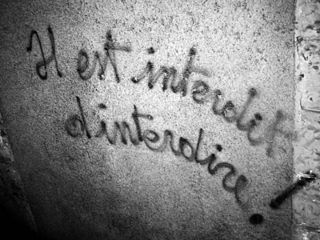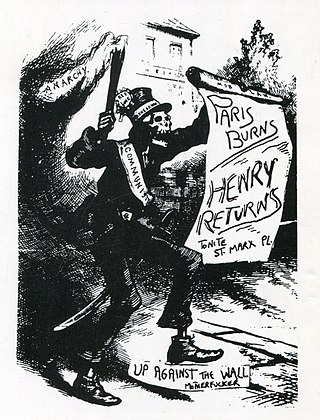Related Research Articles

Graffiti is art that is written, painted or drawn on a wall or other surface, usually without permission and within public view. Graffiti ranges from simple written words to elaborate wall paintings, and has existed since ancient times, with examples dating back to ancient Egypt, ancient Greece, and the Roman Empire.

The Orange Alternative is a Polish anti-communist underground movement, started in Wrocław, a city in south-west Poland and led by Waldemar Fydrych, commonly known as Major in the 1980s. Its main purpose was to offer a wider group of citizens an alternative way of opposition against the authoritarian regime by means of a peaceful protest that used absurd and nonsensical elements.

The Situationist International (SI) was an international organization of social revolutionaries made up of avant-garde artists, intellectuals, and political theorists. It was prominent in Europe from its formation in 1957 to its dissolution in 1972. The intellectual foundations of the Situationist International were derived primarily from libertarian Marxism and the avant-garde art movements of the early 20th century, particularly Dada and Surrealism. Overall, situationist theory represented an attempt to synthesize this diverse field of theoretical disciplines into a modern and comprehensive critique of mid-20th century advanced capitalism.
Guerrilla communication and communication guerrilla refer to an attempt to provoke subversive effects through interventions in the process of communication. It can be distinguished from other classes of political action because it is not based on the critique of the dominant discourses but in the interpretation of the signs in a different way. Its main goal is to make a critical non-questioning of the existing, for reasons ranging from political activism to marketing. In terms of marketing, journalist Warren Berger explains unconventional guerrilla-style advertising as "something that lurks all around, hits us where we live, and invariably takes us by surprise". These premises apply to the entire spectrum of guerrilla communication because each tactic intends to disrupt cognitive schemas and thought processing.

A détournement, meaning "rerouting, hijacking" in French, is a technique developed in the 1950s by the Letterist International, and later adapted by the Situationist International (SI), that was defined in the SI's inaugural 1958 journal as "[t]he integration of present or past artistic productions into a superior construction of a milieu. In this sense there can be no situationist painting or music, but only a situationist use of those means. In a more elementary sense, détournement within the old cultural spheres is a method of propaganda, a method which reveals the wearing out and loss of importance of those spheres."

The Letterist International (LI) was a Paris-based collective of radical artists and cultural theorists between 1952 and 1957. It was created by Guy Debord and Gil J. Wolman rejoined by Jean-Louis Brau and Serge Berna as a schism from Isidore Isou's Lettrist group. The group went on to join others in forming the Situationist International, taking some key techniques and ideas with it.

Psychogeography is the exploration of urban environments that emphasizes interpersonal connections to places and arbitrary routes. It was developed by members of the Letterist International and Situationist International, which were revolutionary groups influenced by Marxist and anarchist theory as well as the attitudes and methods of Dadaists and Surrealists. In 1955, Guy Debord defined psychogeography as "the study of the precise laws and specific effects of the geographical environment, consciously organized or not, on the emotions and behavior of individuals." One of the key tactics for exploring psychogeography is the loosely defined urban walking practice known as the dérive. As a practice and theory, psychogeography has influenced a broad set of cultural actors, including artists, activists and academics.

Kevin Llewellyn Callan, better known as Stewart Home, is an English artist, filmmaker, writer, pamphleteer, art historian, and activist. His novels include the non-narrative 69 Things to Do with a Dead Princess (2002), and the re-imagining of the 1960s in Tainted Love (2005). Earlier parodistic pulp fictions work includes Pure Mania, Red London, No Pity, Cunt, and Defiant Pose which pastiche the work of 1970s British skinhead pulp novel writer Richard Allen and combine it with pornography, political agit-prop, and historical references to punk rock and avant-garde art.

Beginning in May 1968, a period of civil unrest occurred throughout France, lasting seven weeks and punctuated by demonstrations, general strikes, and the occupation of universities and factories. At the height of events, which have since become known as May 68, the economy of France came to a halt. The protests reached a point that made political leaders fear civil war or revolution; the national government briefly ceased to function after President Charles de Gaulle secretly fled France to West Germany on the 29th. The protests are sometimes linked to similar movements around the same time worldwide that inspired a generation of protest art in the form of songs, imaginative graffiti, posters, and slogans.

The Priestley Riots took place from 14 July to 17 July 1791 in Birmingham, England; the rioters' main targets were religious dissenters, most notably the politically and theologically controversial Joseph Priestley. Both local and national issues stirred the passions of the rioters, from disagreements over public library book purchases, to controversies over Dissenters' attempts to gain full civil rights and their support of the French Revolution.

Up Against the Wall Motherfucker, often shortened as The Motherfuckers or UAW/MF, was a Dadaist and Situationist anarchist affinity group based in New York City. This "street gang with analysis" was famous for its Lower East Side direct action.

Punk ideologies are a group of varied social and political beliefs associated with the punk subculture and punk rock. It is primarily concerned with concepts such as mutual aid, against selling out, hierarchy, white supremacy, authoritarianism, eugenics, class and classism, while supporting anti-consumerism, anti-corporatism, anti-war, imperialism, conservatism, anti-globalization, gentrification, anti-racism, anti-sexism, gender equality, racial equality, animal rights, free-thought and non-conformity. One of its main tenets is a rejection of mainstream, corporate mass culture and its values. It continues to evolve its ideology as the movement spreads throughout North America from its origins in England and New York and embraces a range of anti-racist and anti-sexist belief systems. Punk does not necessarily lend itself to any particular political ideology as it is primarily anti-establishment although leftist punk is more common due to the prevalence of liberal and conservative ideologies in the status-quo.

Anti-art is a loosely used term applied to an array of concepts and attitudes that reject prior definitions of art and question art in general. Somewhat paradoxically, anti-art tends to conduct this questioning and rejection from the vantage point of art. The term is associated with the Dada movement and is generally accepted as attributable to Marcel Duchamp pre-World War I around 1914, when he began to use found objects as art. It was used to describe revolutionary forms of art. The term was used later by the Conceptual artists of the 1960s to describe the work of those who claimed to have retired altogether from the practice of art, from the production of works which could be sold.

Street art is visual art created in public locations for public visibility. It has been associated with the terms "independent art," "post-graffiti", "neo-graffiti" and guerrilla art.

Since the 1980s, the area surrounding the Sydney inner west suburb of Newtown, New South Wales (NSW), Australia—including the suburbs of Newtown, Enmore, Erskineville, Camperdown and St Peters—has been known for its wide range of prominent graffiti and street art on walls. The public visual art in the Newtown area consists of a variety of styles and methods of execution, including large-scale painted murals, hand-painted political slogans, hand-painted figurative designs, spray painted semi-abstract designs "tags"), and other stylistic developments such as stencil art and street poster art, "Yarn bombing", and sculptural items cast from plaster and other materials.
The Grupo Cine Liberación was an Argentine film movement that took place during the end of the 1960s. It was founded by Fernando Solanas, Octavio Getino and Gerardo Vallejo. The idea of the group was to give rise to historical, testimonial and film-act cinema, to contribute to the debate and offer an open space for dialogue and freedom of expression that was illegal at that time. With strong anti-imperialist ideas, he harshly criticized Peronism and neocolonialism. In the subsequent years other films directors revolved around the active core of the Cine Liberación group.

In the spring and summer of 1715 a series of riots occurred in England in which High Church mobs attacked over forty Dissenting meeting-houses. The rioters also protested against the first Hanoverian king of Britain, George I and his new Whig government. The riots occurred on symbolic days: 28 May was George I's birthday, 29 May was the anniversary of Charles II's Restoration and 10 June was the birthday of the Jacobite Pretender, James Francis Edward Stuart.

The Golden Fleet was a minor left-wing group in Sweden, existing during the end of the 1960s and the beginning of the 1970s. It was ideologically aligned with the Situationist International, an avant-garde revolutionary movement. The Situationists, whose intellectual foundations were derived primarily from libertarian Marxism and the avant-garde art movements of the early 20th century, initially put its emphasis on concepts like unitary urbanism and psychogeography. Gradually the focus moved more towards revolutionary and political theory. Much like the main organ of that particular ideological current, the Situationist International, the Golden Fleet had its heyday around the protests of 1968, gradually disappearing by the first years of the 1970s.

Activists and artists taking part in the 2019–2020 Hong Kong protests use artwork, painting, music, and other forms of artistic expression as a tactic to help spread awareness about the events that have happened in the city. Individuals who create protest art are commonly referred to as the "publicity group" (文宣組). Creating protest art is seen as a peaceful, alternative way for citizens to express their views without participating in protests. Most members work under pseudonyms to protect their identity and stay in line with the movement's leaderless nature.
References
- ↑ "The mob who shouldn't really be here: King Mob". Tate Etc. 1 May 2008. Retrieved 26 August 2023.
- ↑ Cooper, Sam (1 March 2013). "The Peculiar Romanticism of the English Situationists". The Cambridge Quarterly. 42 (1): 20–37. doi: 10.1093/camqtly/bft010 . ISSN 0008-199X.
- ↑ "The Assault on Culture by Stewart Home chapter on Punk".
- ↑ "A Hidden History of King Mob (Posters/Cartoons)". Archived from the original on 22 March 2016.